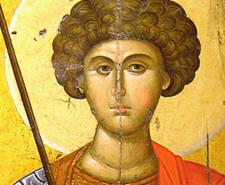
Read more about Ancient History

When you think of St George, a very clear picture probably comes to mind. A knight in shining armour atop a white horse, staring down the ferocious dragon that he’s about to valiantly slay. Adorned with the St George’s cross, this national hero has come to symbolise defiance and bravery in the face of unbeatable odds.
Over 1,000 years after his death, the tale of St George is still very much alive in 21st century England. But who was this brave warrior, and why do we celebrate St George’s Day over a millennium after his death?
Here are five facts about St George that you might not have known.
While there might not be anything more English than flying the St George’s cross, the truth is that St George wasn’t English. In fact, it’s more than likely that he never even set foot in Britain during his lifetime.
Born in Cappadocia (modern-day Turkey) in 270AD, we know next to nothing about his early life, but it’s believed that he died in Lydda (modern-day Israel).
Despite what the artwork on the board outside your local pub shows, St George wasn’t a knight in shining armour. A high-ranking officer of the Roman armies, St George would not have worn the plate armour or wielded the heraldic shield that we associate with him today. Instead, St George would have looked a lot closer to a Roman centurion.
According to the legend passed down for centuries, the town of Selene (modern-day Libya) was being held hostage by a dragon that had a taste for humans. Upon hearing of their plight, St George rode into the town and slayed the dragon in a fierce battle.
Unsurprisingly, though, there wasn’t really a dragon. The reality is that St George refused to denounce his Christian faith, even after he was arrested and tortured. Paraded through town and beheaded in a public execution in 303 AD, George’s martyrdom supposedly inspired thousands of pagans to convert to Christianity.
It is more likely that the story of the dragon rose from the illustrations and illuminations of St George that depicted him facing off with the mythical beast as a metaphor for the Christian fight between good and evil.
It might be hard to imagine, but St George wasn’t always the patron saint of England. The first records of his influence appearing in England can be seen as far back as the court of King Richard the Lionheart. As soldiers returned from the Crusades, they brought with them the tales of St George and his bravery. Inspired by the strength and defiance of the saint in the face of certain death, King Richard I adopted St George’s cross and claimed to be under the saint's protection when he rode into battle.
When King Edward III established the Order of the Garter in 1348, he hoped to establish a chivalric order of knighthood in England equivalent to that of Arthurian legend. Wanting a patron saint that reflected the English values of bravery, honour, and chivalry, King Edward chose St George.
St George is one of the ‘Fourteen Holy Helpers’, a collection of saints that people turn to during times of hardship and strife. Invoking the power of St George was said to protect you from illnesses and diseases like leprosy or the plague.
As well as the power to stave off sickness, many soldiers and knights would turn to St George for protection on the battlefield. He is said to have provided protection for soldiers and was even reported to have appeared on battlefields as recently as the First World War.
Other countries that have claimed George as their patron saint include Ethiopia, Georgia, and Portugal. He’s also the patron saint of farmers and field hands, shepherds, archers and armourers, equestrians, lepers, and chivalry.